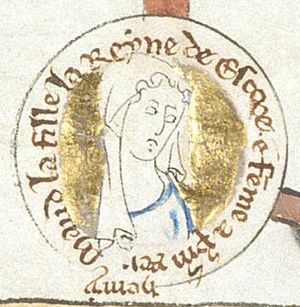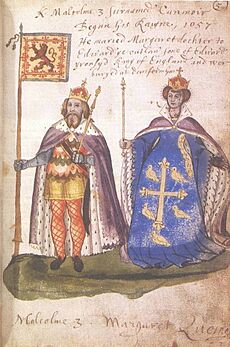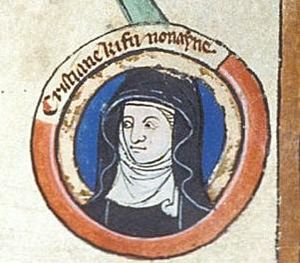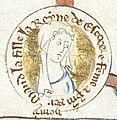Matilda of Scotland facts for kids
Quick facts for kids Matilda of Scotland |
|
|---|---|
 |
|
| Queen consort of England | |
| Tenure | 11 November 1100 – 1 May 1118 |
| Coronation | 11 November 1100 |
| Born | 1080 Dunfermline, Scotland |
| Died | 1 May 1118 (aged 37–38) Westminster Palace, London, England |
| Burial | Westminster Abbey |
| Spouse | |
| Issue | |
| House | Dunkeld |
| Father | Malcolm III of Scotland |
| Mother | Margaret of Wessex |
| Religion | Roman Catholicism |
Matilda of Scotland (born Edith in 1080 – died May 1, 1118) was a powerful queen. People also called her Good Queen Maud. She was the first wife of King Henry I. This made her the Queen of England and Duchess of Normandy.
Matilda often ruled England when King Henry was away. She was a regent in 1104, 1107, 1108, and 1111. Her father was Malcolm III of Scotland, the King of Scotland. Her mother was Margaret of Wessex, an Anglo-Saxon princess. Matilda grew up in a convent in southern England. Her aunt Christina was the head nun there.
In 1093, Matilda was supposed to marry an English nobleman. But her father and brother died in battle that year. Her uncle Donald III then took the Scottish throne. This caused a big fight over who should be king. England helped her half-brother Duncan II become king first. After he died, her brother Edgar became king in 1097.
When Henry I became King of England in 1100, he quickly asked Matilda to marry him. She was related to the old Anglo-Saxon House of Wessex royal family. Marrying her would help make his rule stronger. After it was clear she was not a nun, Matilda and Henry married. As Queen, Matilda started many building projects. These helped with transportation and health. She also helped the Church and supported writers and artists. Many official papers show her signing as regent when her husband was away. Matilda and Henry had two children: Empress Matilda and William Adelin. Through her daughter, Matilda is an ancestor of all future English and British kings and queens. She was buried in Westminster Abbey. People remembered her fondly. Some even tried to make her a saint in the Catholic Church.
Contents
Early Life and Royal Roots
Childhood in Scotland
Matilda was born in 1080 in Dunfermline, Scotland. Her parents were King Malcolm III and Margaret of Wessex. This meant she was related to both Scottish and Anglo-Saxon royal families. She was a great-granddaughter of Edmund Ironside and a descendant of Alfred the Great.
When she was a baby, she was christened Edith. Robert Curthose was her godfather. Queen Matilda of England was her godmother. During her baptism, baby Edith pulled at Queen Matilda's headdress. This was seen as a sign that Edith would one day be a queen herself.
Education at the Convent
Edith and her brothers and sisters were raised by a loving but strict mother. Their mother taught them to be good and religious. When Edith was about six, she and her younger sister Mary went to school. They studied at Romsey Abbey in southern England. Their aunt Christina was the head nun there.
Their studies were more advanced than what most girls learned back then. This was because their mother loved books. The princesses learned English, French, and Latin. This allowed them to read important religious books. It is thought Edith also learned about money management and geometry.
A Time of Trouble in Scotland
While Edith was at Romsey and later at Wilton Abbey, many noblemen wanted to marry her. Even King William II of England thought about marrying her. She turned down proposals from William de Warenne, 2nd Earl of Surrey, and Alan Rufus. However, her parents promised her to Alan Rufus in 1093.
Before the wedding, her father and older brother Edward died. They were killed at the Battle of Alnwick in November 1093. Her mother, Queen Margaret, died soon after hearing this sad news. Edith's uncle Donald III then took the throne of Scotland. Her brothers, Edgar, Alexander, and David, were sent to England for safety. Alan Rufus, her betrothed, then left her and died soon after.
Around this time, Edith left the monastery. This was likely because of the fight for the Scottish throne. In 1093, Archbishop Anselm of Canterbury ordered her to return to the monastery. But Edith did not go back to Wilton. She is not mentioned much in history until 1100. It is likely she joined her brothers at the English court. King William Rufus supported her brother Edgar, who became King of Scotland in 1097.
Becoming Queen of England
A Royal Marriage Proposal
After King William II died in August 1100, his brother Henry quickly took the royal money and crown. Henry was very smart and clever. He was known for ruling strictly but fairly. His next step was to get married. He chose Edith, whom he had known for some time.
Historians say Henry had "long been attached" to her. Some sources also say she was "not bad looking." Edith might have spent time at William Rufus's court with her brothers. This is where she and Henry could have met.
Henry was born in England. But a wife connected to the old Wessex royal family would make him more popular. It would also help bring together the Normans and Anglo-Saxons. Edith was a great-granddaughter of Edmund Ironside from the royal family of Wessex. Their children would unite these two important families. This would make the new royal family stronger.
Another good thing was that England and Scotland became closer. Three of Edith's brothers became kings of Scotland. They were friendly with England. For example, Alexander I married one of Henry I's daughters. David I lived at Henry's court for a while before becoming king.
Proving She Was Not a Nun
Edith had spent much of her life in a convent. So, there was a question about whether she was a nun. If she was, she could not legally marry. While at Romsey Abbey, her aunt Christina made her wear a veil. Edith was strong-willed and wanted to marry. She did not want to stay in a monastery. Her aunt insisted she "was a veiled nun."
When Archbishop Anselm of Canterbury came back to England, Edith went to him. She wanted to prove she had never been a nun. She said her father had even "ripped off the offensive headdress" when he saw her wearing it.
Anselm did not want to decide this important matter alone. He called a meeting of bishops. They needed to decide if the marriage was legal. He also ordered two investigations at Wilton to get information. Edith said she had never taken holy vows. She insisted her parents sent her to the convent only for education. The council agreed that Edith was not a nun. They said she never had been, and her parents did not intend for her to become one. So, they gave permission for the marriage.
Queen of England's Reign
Edith and Henry married on November 11, 1100, at Westminster Abbey. Archbishop Anselm of Canterbury led the ceremony. After the wedding, Edith was crowned. She took the royal name "Matilda." This was a respected Norman name. Historians think she changed her name to please her Norman subjects and husband.
Some courtiers made fun of her and Henry. They called them 'Godric and Godiva.' These were old English names. They thought the couple's style was too simple compared to William II's fancy ways. But Queen Matilda's court at Westminster was full of poets. She was known for supporting the arts, especially music.
Ruling as Regent
Queen Matilda often acted as regent for England. This meant she ruled when her husband was away fighting in Normandy and France. She was the official head of King Henry's court. She traveled around England and probably visited Normandy in 1106–1107.
During a big disagreement between King Henry and Archbishop Anselm (1103–07), Matilda helped. She wrote many letters to Anselm. At first, she asked for his advice and for him to return. Later, she worked to find a solution. With her help, the problem was solved in 1105. The King agreed not to choose his own bishops. But the Church agreed that bishops would still show loyalty to him for the lands they held from him.
Building for the People
Matilda had some land and money from her marriage. This allowed her to manage her own properties. Much of her land had belonged to Edith of Wessex before. King Henry also gave the Queen many gifts, including land in London. This was a smart move to win over the people of London, who strongly supported the old Wessex kings.
Matilda loved architecture. She used her money to build many Norman-style buildings. These included Waltham Abbey and Holy Trinity Aldgate. Once, her group had trouble crossing the River Lea. So, the Queen built the first arched bridge in England at Stratford-le-Bow. She also built a raised path across the marshes.
Like her mother, Matilda was known for helping the poor. She built public toilets at Queenhithe. She also built a bathhouse with running water. She was especially interested in leprosy. She started at least two hospitals for people with leprosy. One of these later became the church of St Giles-in-the-Fields.
A Royal Engagement for Her Daughter
In late 1108 or early 1109, King Henry V of Germany sent people to King Henry I. He wanted to arrange a marriage between himself and King Henry's daughter, Matilda. He also wrote to Queen Matilda about it. This marriage was good for the English king. Marrying his daughter to a powerful European ruler would make his own royal family seem more important. It would also give him an ally against France.
In return, Henry V would get a large sum of money. This money would help him travel to Rome for his coronation as the Holy Roman emperor. The final details were worked out in Westminster in June 1109. Matilda's daughter left England in February 1110 to go to Germany for her wedding.
Queen Matilda's Faith
Queen Matilda was described as a very holy woman. People said she was as religious as her mother. She was remembered by her subjects as Mathilda bona regina (Matilda the good queen). For a time, people tried to have her made a saint, but it did not happen.
Matilda was known for being very generous to the church. She founded and supported religious houses and hospitals for people with leprosy. One writer said she would go to church barefoot during Lent. She would also wash the feet and kiss the hands of sick people. Queen Matilda supported the writing of a version of The Voyage of Saint Brendan. She also asked a monk to write a biography of her mother, Saint Margaret.
Matilda's Children
King Henry had many children with different women. But he and Matilda had two children who grew up:
- Matilda (born February 7, 1102 – died September 10, 1167)
- William Adelin (born August 5, 1103 – died November 25, 1120)
Some historians think they might have had a baby who was born too early in July 1101. Through her daughter Matilda, the kings and queens of England after the Norman conquest were related to the old Anglo-Saxon House of Wessex monarchs.
Death and Legacy
Queen Matilda died on May 1, 1118, at Westminster Palace. It is said that three of her Anglo-Saxon ladies-in-waiting were so sad that they became nuns right away. Matilda wanted to be buried at Holy Trinity, Aldgate. But King Henry asked for her to be buried at Westminster Abbey. Her tomb says: "Here lies the renowned queen Matilda the second, excelling both young and old of her day. She was for everyone the benchmark of morals and the ornament of life."
Matilda's son, William Adelin, died in a terrible shipwreck in 1120. Her husband, King Henry, did not have another son with his second wife. This led to a big fight over who would be the next ruler. This fight caused a long civil war. Later, King Stephen of Blois claimed that Queen Matilda had actually been a nun. He said this meant her daughter, Empress Matilda, could not legally be the next queen of England.
Queen Matilda's good reputation grew during the reign of her grandson Henry II. However, people remembered her less and less in the later 1200s and 1300s.
Images for kids
See also
 In Spanish: Matilde de Escocia para niños
In Spanish: Matilde de Escocia para niños






